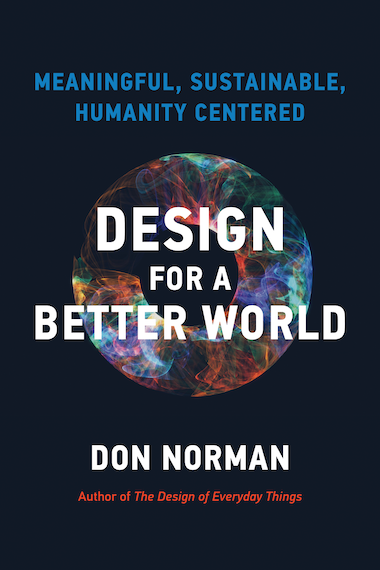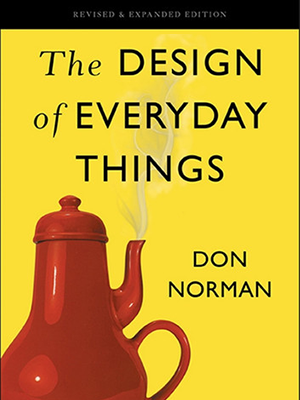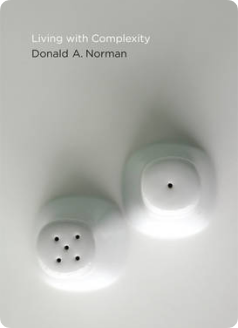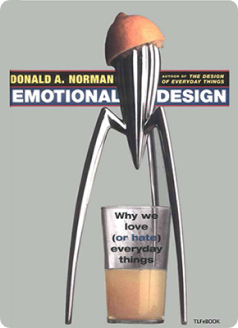
Design for a Better World
Design for a Better World
Meaningful, Sustainable, Humanity Centered
Human behavior brought our world to the brink, human behavior can save us.
The world is a mess. Our dire predicament, from collapsing social structures to the climate crisis, has been millennia in the making and can be traced back to the erroneous belief that the earth’s resources are infinite. The key to change, says Don Norman, is human behavior, covered in the book’s three major themes: meaning, sustainability, and humanity-centeredness. Emphasize quality of life, not monetary rewards; restructure how we live to better protect the environment; and focus on all of humanity. The book presents an eye-opening diagnosis of where we’ve gone wrong and a clear prescription for making things better.
Norman proposes a new way of thinking, one that recognizes our place in a complex global system where even simple behaviors affect the entire world. He identifies the economic metrics that contribute to the harmful effects of commerce and manufacturing and proposes a recalibration of what we consider important in life. His experience as both a scientist and business executive gives him the perspective to show how to make these changes while maintaining a thriving economy. Let the change begin with this book before it’s too late.
Praise for Design for a Better World
“Don Norman joining the movement for…”
Don Norman joining the movement for responsible and sustainable design brings considerable heft to the demand for design to transform from a user-centric focus to serving society and the planet as a whole
Leyla Acaroglu. UN environmental program “Champion of the Earth” award; Founder and Sustainability lead of “Disrupt Design”
“Norman does it again with this essential book…”
Norman does it again with this essential book! His profound wisdom provides a mobilizing awareness for everyone. In this age of waste, unsustainability and total irresponsibility, this book makes us rethink our ways of life. (See her full review below.)
Anne Asensio. Vice-President Design, Dassault Systèmes; Board Member, World Design Organization; Member of the Circular Design leaders circle, Ellen MacArthur Foundation.
“Through examples from science…”
Through examples from science, technology, design, philosophy, and human behavior, Norman narrates the current global challenges and shows how design can play an essential role for making the world a better place. Yet another classic!
Srini Srinivasan. Senator & Past-President, World Design Organization; Chief Operating Officer, Design Innovation Institute, Shanghai, China
“Norman’s book shifts focus from the human to humanity...”
Norman’s book shifts focus from the human to humanity, cracking the code on what values ought to be at the center when driving sustainable design. The message is loud and clear–the future of humanity is the future of the planet.
Payal Arora, Professor and Chair, Technology, Values, and Global Media Cultures, Erasmus University; author of The Next Billion Users.
Anne Asensio’s Full review (It had to be shortened for the cover)
“Don Norman made it again with this essential book!“
His “searcher” attitude and profound wisdom, restitutes a “grounded” mobilizing awareness not only for the designers but also to every one of us. We live in the age of waste, unsustainability and total irresponsibility when it comes to our mediation to the world. If design must change from being unintentionally destructive to being intentionally constructive, it implies massive changes to redefine what is considered ”good”, a total rethink of our way of life.
It starts by realizing that Human is the most critical aspect of today’s difficulties. It may also be the opportunity. To regenerate the world we live in, the physical, technological, and economical issues must be solved “through and with” a design mindset. From human to humanity centered, the empowerment of all, designing with people, by people and not for them, embracing complexity as well as wicked social and societal eco-systems on the change of political agenda and policy-making, this is the roadmap Don Norman urges us to follow. Toward a constant quest for a more sustainable and desirable world, we, the people of earth, have work to do. We must make our voices heard. The rise of our consciousness will spur with this book.
Anne Asensio is a designer, Vice-President of Design, Dassault Systèmes; Board Member of the World Design Organisation; Member of Circular Design leaders circle, Ellen MacArthur Foundation.
Worth Magazine Review
https://www.worth.com/mixed-media-stanley-tucci-a-design-pioneer-and-placemaking/
Retrospectives challenge even the most gifted of curators. Looking back is rarely as successful as hoped. U2’s “Songs of Surrender” is an unnecessary, indulgent gloss on a legacy that does not require it. The hagiographied Joan Didion’s Let Me Tell You What I Mean added nothing to the verve and dynamism of the original essays—a mere commercial repackaging. The gargantuan Guggenheim Alex Katz retrospective was harrowingly good at creating more detractors than devotees.
So what should we make of Don Norman’s latest work Design for a Better World: Meaningful, Sustainable, Humanity Center? Is the sui generis thinker, who gave frame and language to a movement that has shaped much of our contemporary relationship with consumer products, engaging in regurgitation (at worst), retrospective (slightly better), or, dare we imagine it, revelation?
The question, though it does not sound like it, is a compliment. Looking back—and looking deeper—at one’s foundational work is a luxury afforded only to those whose dent in the universe was sufficiently deep to deserve a second or sixty-sixth glance.
Norman qualifies. His Design of Everyday Things, first published 25 years ago, was a seminal work of the now-ubiquitous concept of user-first design. His work is as likely to be evoked by transit designers and city planners as front-end developers, industrial creatives, automotive designers, and beyond. How to escape the gravity of such a profound accomplishment would be a puzzle for any artist. Norman seems to know this and thus doesn’t try. Instead, he keeps faith with his original premise while bringing new queries to his first principles. The result is a brave attempt to expand the scope of what one considers the possibility and responsibility of good design.
Such bravery is required, as the backdrop of this work is notably darker than that of his break-out thesis. Quite literally, the weather has changed. The tactics that Norman popularized seem quaint against planetary distress caused, at least in part, by the efficient application of his ideas. Can we design our way out of a problem we designed? The question requires multi-dimensional thinking and an unlikely blend of hubris and humility. Lucky for us, Norman is an endlessly curious polymath, and the book approaches its basic query with cross-disciplinary choreography. Diverging, then converging; zooming into the microscopic and back out to the cosmic; visiting crowd-sourced solutions before navigating the bureaucracy of cities and nations. Norman finds everywhere a common problem: artificiality, an approach to designing systems and products that jettisons meaning, disregards negative externalities, and, worst of all, masquerades as natural order. To rebel against the tyranny of the artificial requires messianic intervention by the Norman-esque ideal of a designer. As said, he keeps the faith.
In the broadened mandate for designers, Norman’s no longer interested in your teapot. He’s after the big structures that govern our hours and epochs: Work, Education, Healthcare, Politics, and Rewards. If Norman’s right, the next decades will introduce a set of liberating new approaches to living in society. If he’s wrong, we’ll have succeeded at designing our own effortless catastrophe.
Table of Contents
(Chapters 1, 6, and 35 are clickable and provide the entire chapter. Clicking on Chapter 22 provides the key ideas. My ability to provide the book chapters is controlled by the publisher, MIT Press.)
I: ARTIFICIAL: ALMOST EVERYTHING I SEE IS ARTIFICIAL
Chapter 1: Almost Everything Artificial Has Been Designed (click to view in new tab)
Chapter 2: Our Artificial Way of Life Is Unsustainable
Chapter 3: Why History Matters
Chapter 4: Precise – but Artificial — Measurements
Chapter 5: If Technology Got us into Today’s Situation, Maybe Technology Can Get Us Out
Chapter 6: This Book: Meaningful, Sustainable, and Humanity-Centered (click to view in new tab)
II MEANINGFUL: COMMUNICATE IN UNDERSTANDABLE WAYS
Chapter 7: The Need for Meaning
Chapter 8: Measurement in the Physical Sciences
Chapter 9: Measuring What Is Important to People
Chapter 10: The Gross Domestic Product
Chapter 11: What Measures Are Truly Important to People?
Chapter 12: Human Behavior and Economics
III SUSTAINABLE: REVERSE AND REPAIR THE HARM DONE TO THE ECOSYSTEMS OF THE WORLD
Chapter 13: We Live in the Age of Waste
Chapter 14: How Did the World Get into Today’s Quandary?
Chapter 15: Sustainability Has Multiple Components and Implications
Chapter 16: Design, Products, Sustainability, and the Circular Economy
Chapter 17: The Practical Difficulties of Implementing Circular Design
Chapter 18: Sustainable, Robust, and Resilient Systems
Chapter 19: People’s Understanding of Systems
Chapter 20: Working With Complex Sociotechnical Systems
Chapter 21: It Is Not Too Late
IV HUMANITY CENTERED: ADDRESS ALL ASPECTS OF THE WORLD RELEVANT TO LIFE
Chapter 22: Moving from Humans to Humanity (click to view the critical argument in a new tab)
Chapter 23: Democratizing Design and Development
Chapter 24: People Designing for Themselves
Chapter 25: Design X: An Approach to Large, Complex Systems
Chapter 26: Where Incrementalism (Muddling Through) Fails
Chapter 27: Incremental Modular Design
Chapter 28: When Large, Multidisciplinary Projects Are Necessary
Chapter 29: Dealing with Scale
Chapter 30: Design: Necessary but not Sufficient
V HUMAN BEHAVIOR: THE MAJOR CHALLENGE
Chapter 31: Why Change Is Difficult
Chapter 33: People Will Mobilize for a Common Goal
Chapter 33: What Must change?
Chapter 34: The Dominance of Technology.
Chapter 35: The Future of Technology (click to view in new tab)
VI ACTION: LEARN, REFLECT, DECIDE, ACT
Chapter 36: What Can Be Done?
Chapter 37: What Can We Do?
Chapter 38: The Major Points of this Book
Acknowledgments
Notes
Bibliography
Index
For Grammarians Only:
Why is Humanity-Centered Design not hyphenated on the cover, even though it is hyphenated in the text?
In the draft of the book, I had hyphenated the phrase wherever it appeared. The original cover also hyphenated the phrase. But Virginia Crossman, my truly excellent copy editor, de-hyphenated it on the cover.
I sent her a note pointing out her error. Worse, I said, if she took the hyphen out on the cover, she had to remove it from the text for both human-centered and humanity-centered. The easiest thing to do would be just to put the hyphen back on the cover. My editor, Noah Springer, the acquisitions’ editor for the book who also helped me completely restructure the book, agreed with me.
But Ginny pointed out that:
We (MIT Press) follow the Chicago Manual of Style when it comes to hyphenation rules. They have a long chart about all the various types of word combinations that can be hyphenated (see CMS 7.89), but in general, compounds are hyphenated when they appear before the noun they are modifying to clarify their role in the sentence. When they appear after the noun they modify, or without it, they are not hyphenated as it’s not needed to understand the relationship between the words. This guidance has been followed throughout the text for all kinds of compounds.
I responded: “yes, I understand the rule. That doesn’t explain why the phrase is handled differently in the text than in the book title.”
Ginny responded:
The phrase in the title does not appear before a noun, and so it does not use a hyphen. It’s consistent with the treatment of the phrase in the text (hyphenated when before a noun, open otherwise), and is correct as is.
I gave up. Ginny, I suspect, has memorized all the 970 or so pages of the Chicago Manual of style. Moreover, this is a very good example of the kind of conflicts that occur frequently in design, when two fundamental rules, each of them excellent and reasonable by themselves, conflict with one another. In this case, the two rules are:
- Hyphenate a compound term to make it clear that the total term modifies the noun that follows. But do not hyphenate when there is no following noun;
- Be consistent. Whatever design pattern is used in one part of a product should be used consistently throughout the product, otherwise it is confusing to those using the product.
I suggest that although rule 1 is sensible, it should not deny the use of hyphens even when they are technically not needed. In other words, I put consistency before grammar.
But there is no right or wrong in selecting among conflicting rules. Which rules should dominate depends upon many factors, most importantly the perspectives and viewpoints of the people making use of the result. Even here, however, different viewers might have different opinions, so the correct choice for some people might be incorrect for others. Here, the designer must choose.
The conflict has one nice side benefit. It provides an opportunity to turn the conflict into a design lesson.
And so now you, dear reader, understand. Right?


